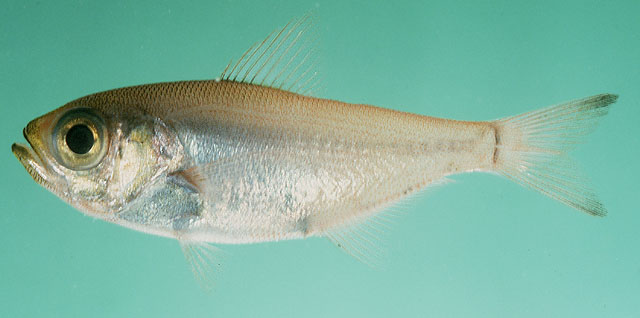| Pempheridae (Sweepers) |
| 5.4 cm SL (male/unsexed); 5.3 cm SL (female) |
|
reef-associated; marine; depth range - 14 m |
| Western Indian Ocean: Oman. |
|
Dorsal spines (total): 6-6; Dorsal soft rays (total): 9-9; Anal spines: 3-3; Anal soft rays: 20-22. This species is characterized by the following: D VI,9; A III,20 (20-22); pectoral-fin rays 15-16 (often 16); lateral-line scales 65 (64-69); scale rows above lateral line to base of dorsal fin 5.5; gill rakers 25 (24-26, modally 25); body depth 3.2 (3.1-3.2) in SL, width 2.1 (2.0-2.15) in body depth; depth of caudal-peduncle 10.2 (9.5-10.1) in SL; head length 3.0 (2.85-3.0) in SL; snout length 12.2-12.9 in SL; relatively large eye, orbit diameter 7.5 (7.6-7.8) in SL with interorbital width 13.1 (12.0-14.0); mouth forming an angle of about 60° to horizontal axis of body; slender, recurved teeth in 2 irregular rows in upper row that project downward and becoming progressively smaller to end of the jaw; lower jaw with two medial rows of strongly recurved and inward-projecting teeth, reducing to a single row for remainder of jaw; vomer and palatines with small, incurved, sharply conical teeth in a single irregular row; thin upper lip, densely covered with dark purple papillae while lower lip has smaller, more widely spaced papillae; tongue broadly triangular, indented slightly on sides near tip, forming a small, rounded tip; predorsal length 2.5 (2.4-2.45) in SL; first dorsal-fin soft ray is longest, 4.4 (4.6-4.65) in SL; caudal fin forked with fin length 3.9 (3.95 and broken) in SL; pectoral-fin length 3.5 (3.45-3.55) in SL; prepelvic length 2.75 (2.5-2.7) in SL; pelvic fins not reaching the anus, fin length 5.0 (5.1-5.3) in SL; preanal length 1.55 (1.5-1.6) in SL; without a pin-like dark line anterior to anus; golden iris in preserved holotype (Ref. 107896). |
| Collected from a cave in a drop-off by rotenone (Ref. 107896). |
|
Not Evaluated (N.E.) Ref. (130435)
|
| harmless |
Source and more info: www.fishbase.org. For personal, classroom, and other internal use only. Not for publication.

